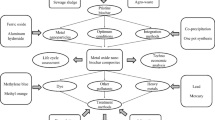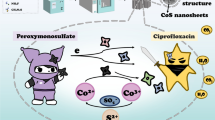Abstract
The interaction between Shewanella oneidensis MR-1 and the soluble metal Pd(II) during the reductive precipitation of Pd(0) determined the size and properties of the precipitated Pd(0) nanoparticles. Assessment of cell viability indicated that the bioreduction of Pd(II) was a detoxification mechanism depending on the Pd(II) concentration and on the presence and properties of the electron donor. The addition of H2 in the headspace allowed S. oneidensis to resist the toxic effects of Pd(II). Interestingly, 25 mM formate was a less effective electron donor for bioreductive detoxification of Pd(II), since there was a 2 log reduction of culturable cells and a 20% decrease of viable cells within 60 min, followed by a slow recovery. When the ratio of Pd:cell dry weight (CDW) was below 5:2 at a concentration of 50 mg l−1 Pd(II), most of the cells remained viable. These viable cells precipitated Pd(0) crystals over a relatively larger bacterial surface area and had a particle area that was up to 100 times smaller when compared to Pd(0) crystals formed on non-viable biomass (Pd:CDW ratio of 5:2). The relatively large and densely covering Pd(0) crystals on non-viable biomass exhibited high catalytic reactivity towards hydrophobic molecules such as polychlorinated biphenyls, while the smaller and more dispersed nanocrystals on a viable bacterial carrier exhibited high catalytic reactivity towards the reductive degradation of the anionic pollutant perchlorate.
Similar content being viewed by others
References
Amonette JE, Workman DJ, Kennedy DW, Fruchter JS, Gorby YA (2000) Dechlorination of carbon tetrachloride by Fe(II) associated with goethite. Environ Sci Technol 34:4606–4613
Averback RS, Bernholc J, Nelson DL (1991) Clusters and cluster-assembled materials. Materials Research Society, Pittsburgh
Baxter-Plant V, Mikheenko IP, Macaskie LE (2003) Sulphate-reducing bacteria, palladium and the reductive dehalogenation of chlorinated aromatic compounds. Biodegradation 14:83–90
Ben Amor K, Breeuwer P, Verbaarschot P, Rombouts FM, Akkermans ADL, De Vos WM, Abee T (2002) Multiparametric flow cytometry and cell sorting for the assessment of viable, injured, dead bifidobacterium cells during bile salt stress. Appl Environ Microbiol 68:5209–5216
Boon N, Depuydt S, Verstraete W (2006) Evolutionary algorithms and flow cytometry to examine the parameters influencing transconjugant formation. FEMS Microbiol Ecol 55(1):17–27
Caccavo F, Blakemore RP, Lovley DR (1992) A Hydrogen-oxidizing, Fe(III)-reducing microorganism from the Great Bay Estuary, New-Hampshire. Appl Environ Microbiol 58:3211–3216
Caccavo F, Schamberger PC, Keiding K, Nielsen PH (1997) Role of hydrophobicity in adhesion of the dissimilatory Fe(III)-reducing bacterium Shewanella alga to amorphous Fe(III) oxide. Appl Environ Microbiol 63:3837–3843
Carpentier W, Sandra K, De Smet I, Brige A, De Smet L, Van Beeumen J (2003) Microbial reduction and precipitation of vanadium by Shewanella oneidensis. Appl Environ Microbiol 69:3636–3639
Davey HM, Douglas DB, Kaprelyants AS (1999) Estimation of microbial viability using flow cytometry. In: Robinson P, Darzynkiewics P, Dean P, Orfao A, Rabinovitch P, Tank H, Wheeless L (eds) Current protocols in cytometry. Wiley, New York, pp 11.3.11–11.3.20
De Windt W, Aelterman P, Verstraete W (2005) Bioreductive deposition of palladium (0) nanoparticles on Shewanella oneidensis with catalytic activity towards reductive dechlorination of polychlorinated biphenyls. Environ Microbiol 7:314–325
De Windt W, Boon N, Siciliano SD, Verstraete W (2003) Cell density related H2 consumption in relation to anoxic Fe(0) corrosion and precipitation of corrosion products by Shewanella oneidensis MR-1. Environ Microbiol 5:1192–1202
Geyer HJ, Scheunert I, Korte F (1987) Correlation between the bioconcentration potential of organic environmental chemicals in humans and their n-octanol water partition coefficients. Chemosphere 16:239–252
Glasauer S, Langley S, Beveridge TJ (2001) Sorption of Fe (hydr)oxides to the surface of Shewanella putrefaciens: Cell-bound fine-grained minerals are not always formed de novo. Appl Environ Microbiol 67:5544–5550
Glasauer S, Langley S, Beveridge TJ (2002) Intracellular iron minerals in a dissimilatory iron-reducing bacterium. Science 295:117–119
Ichinose N (1992) Superfine particle technology. Springer-Verlag, Berlin
Jorand F, Appenzeller BMR, Abdelmoula M, Refait P, Block JC, Genin JMR (2000) Assessment of vivianite formation in Shewanella putrefaciens culture. Environ Technol 21:1001–1005
Joux F, Lebaron P (2000) Use of fluorescent probes to assess physiological functions of bacteria at single-cell level. Microbes Infect 2:1523–1535
Kielhorn J, Melber C, Keller D, Mangelsdorf I (2002) Palladium - A review of exposure and effects to␣human health. Int J Hyg Environ Heal 205: 417–432
Kim S, Picardal FW (1999) Enhanced anaerobic biotransformation of carbon tetrachloride in the presence of reduced iron oxides. Environ Toxicol Chem 18:2142–2150
Livingstone SE (1973) Palladium: the element. In: Bailar JC, Nyholm R, Trotman-Dickenson AF (eds) Comprehensive inorganic chemistry. Pergamon Press, Oxford
Liu TZ, Lee SD, Bhatnagar RS (1979) Toxicity of palladium. Toxicol Lett 4(6):469–473
Lloyd JR, Yong P, Macaskie LE (1998) Enzymatic recovery of elemental palladium by using sulfate-reducing bacteria. Appl Environ Microbiol 64:4607–4609
Lovley DR, Phillips EJP, Gorby YA, Landa ER (1991) Microbial reduction of uranium. Nature 350:413–416
Mabbett AN, Yong P, Farr JPG, Macaskie LE (2004) Reduction of Cr(VI) by “palladized” biomass of Desulfovibrio desulfuricans ATCC 29577. Biotechnol Bioeng 87:104–109
Macaskie LE, Baxter-Plant VS, Creamer NJ, Humphries AC, Mikheenko IP, Mikheenko PM, et al (2005) Applications of bacterial hydrogenases in waste decontamination, manufacture of novel bionanocatalysts and in sustainable energy. Biochem Soc T 33:76–79
McCormick ML, Adriaens P (2004) Carbon tetrachloride transformation on the surface of nanoscale biogenic magnetite particles. Environ Sci Technol 38:1045–1053
Nollet H, Lutgen P, Verstraete W (2002) Chemical removal of PCBs from water samples under ambient conditions. J Chem Technol Biot 77:517–524
Rosenberg M, Gutnick D, Rosenberg E (1980) Adherence of bacteria to hydrocarbons : a simple method for measuring cell surface hydrophobicity. FEMS Microbiol Lett 9: 29–33
Sakaguchi T, Arakaki A, Matsunaga T (2002) Desulfovibrio magneticus sp nov., a novel sulfate-reducing bacterium that produces intracellular single-domain-sized magnetite particles. Int J Syst Evol Micr 52:215–221
Sambrook J, Russell DW (2001) Molecular cloning: a laboratory manual, 3rd edn. Cold Spring Harbor Laboratory, Cold Spring Harbor
Shaw GR, Connell DW (1984) Physicochemical properties controlling polychlorinated biphenyl (PCB) concentrations in aquatic organisms. Environ Sci Technol 18:18–23
Spacie A, Hamelink JR (1982) Alternative models for describing the bioconcentration of organics in fish. Environ Toxicol Chem 1:309–320
Truex MJ, Peyton BM, Valentine NB, Gorby YA (1997) Kinetics of U(VI) reduction by a dissimilatory Fe(III)-reducing bacterium under non-growth conditions. Biotechnol Bioeng 55:490–496
Yong P, Rowson NA, Farr JPG, Harris IR, Macaskie LE (2002) Bioreduction and biocrystallization of palladium by Desulfovibrio desulfuricans NCIMB 8307. Biotechnol Bioeng 80:369–379
Acknowledgments
This work was supported by a grant from the Fund for Scientific Research in Flanders within scope of the FWO project with accession number G.0054.02. The authors wish to thank Nico Boon, Bram Pauwels and Korneel Rabaey for critically reading the manuscript.
Author information
Authors and Affiliations
Corresponding author
Rights and permissions
About this article
Cite this article
De Windt, W., Boon, N., Van den Bulcke, J. et al. Biological control of the size and reactivity of catalytic Pd(0) produced by Shewanella oneidensis . Antonie van Leeuwenhoek 90, 377–389 (2006). https://doi.org/10.1007/s10482-006-9088-4
Received:
Accepted:
Published:
Issue Date:
DOI: https://doi.org/10.1007/s10482-006-9088-4




